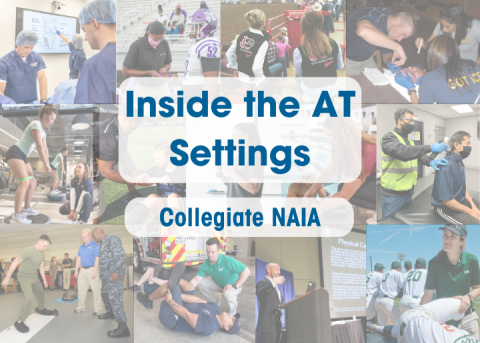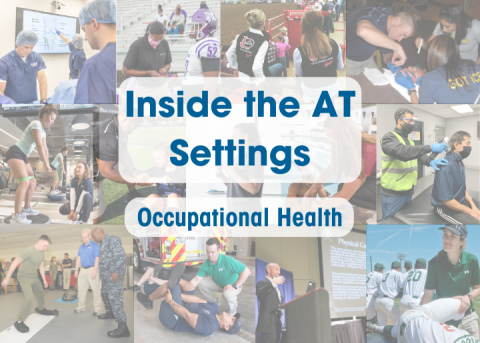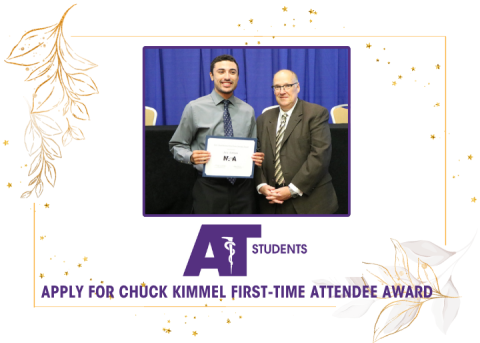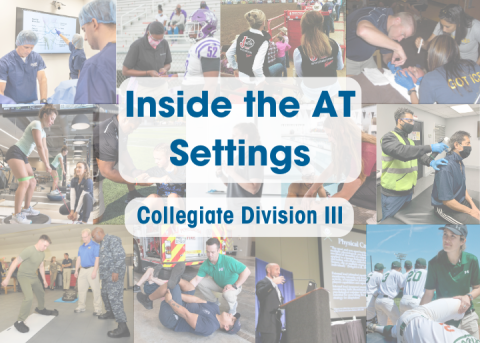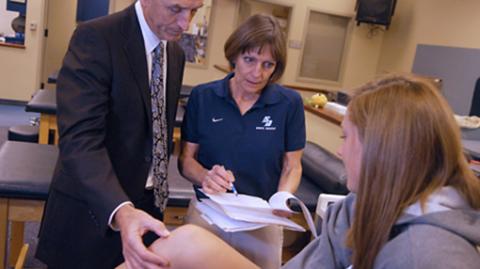
Contributed by the NATA Secondary School Athletic Trainers' Committee
Communication is key in all levels of athletic training, but the secondary school setting presents unique communication challenges. Here are some tips for communicating with parents, coaches and physicians.
Communicating with Parents: Making Parents Allies
By Lori Johannessen, ATC, LAT
I have heard it said by ATs working outside of the secondary school setting that parents get in the way and impede an AT’s ability to care for his/her athletes. As a secondary school AT, I am here to tell you that parents can actually be your allies.
The best way to get parents on board is to communicate! Think of your job as part public relations, and talk to them early and often. Get to know them before an injury occurs. This includes being visible at events, taking the time to explain to them what is going on with their child, even when it is minor. Speak at your athletic department preseason meetings and provide information about yourself, athletic training and injury prevention/care. Post this information on your school's web page. Parents want to know that you are there to care for their children. If you are established as a trusted resource prior to an injury occurrence, you are more likely to be looked upon as a resource when injury strikes. This relationship will help you to provide the best quality care to the athlete.
Overall, parents want what is best for their children. The challenge lies in the fact that they often do not always know what is best. As we all know, parents are not given a handbook at birth, and sometimes the myopic view of their child’s unhappiness causes blurry vision in parents. When that occurs, it becomes your job to educate the parents about the condition, treatment options, risks and potential outcomes. Demonstrate how much you care about their children and that you are striving toward the best outcome now and into their future. Very few parents will continue to fight you once they understand the injury and correct course of action.
Reach out! Make follow up calls to see how the athlete is doing after an injury. Engage the parent. Provide them with details and help establish yourself as an ally, working as a team to achieve the ultimate goal – a healthy student athlete.
With parents on your side, your job becomes easier and the athlete will be safer. Now you have adults who care about student athletes’ wellbeing in your corner. They will help encourage follow-up care at home. For example, the parents will monitor little Johnny, who may have a concussion, at home and let you know he is keeping his music low even though he claims he no longer has symptoms. Parents can also be very strong advocacy groups. They will fight to keep you there, and to help secure more equipment and supplies to help you take care of their children.
Making parents your allies is a matter of approach. You are on the same side, with the same goal: protecting and caring for student athletes.
I know I have had my share of challenges with parents, but overall I can sleep at night knowing a loving parent is monitoring the concussed athlete rather than a random roommate. The bottom-line: Parents should be your best allies when it comes to caring for the health and well being of children (athletes).
Communicating with Coaches: What to Discuss at Coaches' Meetings
By Daniel Quigley, MSEd, ATC, LAT
Preseason and postseason meeting with coaches can be very helpful to all who deal with secondary school athletes. These meetings should be set up in advance and all coaches and ATs need to be there.
Most secondary school athletic departments have preseason meeting with coaches and athletic directors. If the AT is not included in this meeting, you need to talk to the AD and get on the agenda. Talking with the coaches and administration is just as important as anything else that will be discussed at the meeting. The more information that can be disseminated at the meeting the easier it will be for all during the season. There are a few topics that must be addressed at this meeting.
- JOB DUTIES: The specific duties of the AT need to be shared with the coaching staff. They need to be spelled out so that there is no confusion about who does what and what is expected of all parties. This can include but is not limited to: presence at games/practices, travel to away events, supplies at games/practices, AT facility times.
- ATHLETIC TRAINING RULES AND REGULATIONS: These need to be distributed and followed. It will make the difference between a smooth running program and constant problems. This should include but is not limited to: proper behavior of athletes and coaches while in the AT facility, use or non use of electronic devices (ie: cell phones), proper attire, sign in procedures and privacy issues. This can be modified to meet any specific setting and preferences of the individual AT. These rules and regulations should also be posted in the AT facility.
- COMMUNICATION: This is the key to any organization. The AT needs to explain to the coaches how to get in contact with him/her. This should include a cell phone number, fax number and email address. Depending on how the AT is hired and personal preferences, contact after practice/game hours can be decided. The AT can also discuss polices on communication with parents. ALL medical issues should go through the AT first. The coaches should not be offering medical advice or making decisions. The chain of command can also be addressed here as it pertains to what information is given to who. HIPPA and FERPA laws also need to be discussed at this point. Better to take a few minutes to remind the coaches on the law than to have to deal with lawyers in the future.
These are just a few suggestions of the topics that need to be addressed. ATs can modify this to fit the specific needs of their school and circumstances. An AT will want to discuss this with the AD first to make sure there is administrative support. The better organized the AT, the better the work setting will be. It also demonstrates we are highly educated medical professionals, which helps to bolster respect for the individual and profession.
Always remember, coaches are not ATs and ATs are not coaches. We all have our specific roles. ATs work with coaches, not for them.
Communicating with Physicians
By Chris Dean, ATC
When I first began my journey to become an athletic trainer, I remember spending a few hours as a student in the airport with our team physician. Never one to waste an opportunity, I asked him what makes a great athletic trainer. As he often did, he turned it around and asked what made a great team physician. As our discussion continued, we found that our points of emphasis were essentially the same: great communication, commitment to quality care above all, mutual trust and, most of all, mutual respect.
As ATs, I wholeheartedly believe we all share an underlying commitment of quality care to the athletes we serve. Trust and respect are earned through working together and supporting each other. Therefore, communication is the easiest skill we can improve to more effectively work with our team physician.
The easiest way to communicate with your team physician is to talk like a physician. Clear, concise reporting, accurate presentation and specific anatomical terminology all go a long way in establishing your expertise and building the rapport and trust that is so crucial in that relationship. I have provided a few links that may be beneficial for you as an athletic trainer:
- Guidelines for Case Presentations via Cornell University
- A Practical Guide to Clinical Medicine via the University of California, San Diego
- Types of Bone Fractures via InnerBody.com
- Salter-Harris Fractures via Radiopaedia.org
- Recognizing and Describing Fractures via LearningRadiology.com

